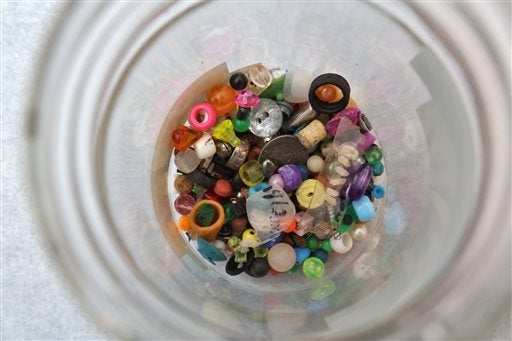Doctors keep collection of strange items swallowed by kids
COLUMBUS, Ohio (AP) – Dr. Charles Elmaraghy collects his surgical success stories.
He and his colleagues in the ear, nose and throat division of Nationwide Children’s Hospital keep a jar filled with all the tiny, colorful items they’ve rescued from deep inside kids’ ears, noses and mouths.
From just the past couple of months, the jar contains dozens of beads, coins, pebbles and jewels.
“Children will stick anything in any orifice,” said Elmaraghy, chief of pediatric otolaryngology at the hospital.
His “foreign bodies” jar – which also holds a 2-inch long, decaying stick – is proof. The stick was removed from a 6-year-old’s nose, said Linda Payne, a nurse and the clinical lead for Children’s ear, nose and throat division.
The boy was sledding down a hill, Payne said, and the next thing he knew, the stick was wedged in his nose. Sideways.
“That might be our strangest, most unusual nasal foreign-body case,” Payne said.
After years of seeing patients who have managed to lodge just about everything imaginable in hard-to-reach places, Elmaraghy has settled on a few favorite stories.
A few years ago, one girl swallowed her mom’s 1-carat diamond earring. It went down her windpipe and got stuck in one of her lungs. Elmaraghy remembers the mother firing off frantic questions about the condition of the jewel – but none about her daughter.
Another time, a girl stuck a tiny high-heeled shoe from a Polly Pocket play set up her nose. To remove it, Elmaraghy used an instrument that fit into the sole of the tiny shoe like an actual foot might have.
“You have to get pretty creative when you remove them,” he said.
Payne’s favorite case involved an older patient, maybe 7 or 8 years old, who was trying to hear the ocean through a small, eraser-size seashell. The boy couldn’t explain to nurses how the shell wound up inches-deep in his ear.
Most culprits are 2 to 4 years old, Elmaraghy said.
Some weeks, he’ll see as many as seven patients who need anesthesia and endoscopic surgery to remove deeply stuck foreign objects.
Payne said that each day in the clinic, she handles a couple of less-severe cases, usually involving noses and ears. Those rarely require sedation. Instead, the nurses use their “arsenal of instruments,” as Elmaraghy put it, to remove the object. It usually takes only a few seconds.
The reason kids stick strange objects into their body, they said, is because they’re curious.
“They discover that hole in their nose and they don’t know really where it goes or what it does,” Elmaraghy said.
“They don’t always understand … that it may go in, but probably won’t come out,” Payne said.
It’s one of their first exposures to cause and effect, Elmaraghy said. “What happens if I shove this rock in my nose?”
What happens is they go to the doctor to get it taken out, which, Elmaraghy said, often teaches them a lesson.
“But we have had some repeat offenders.”
In the right hands, the removal procedure is safe and almost always ends well, he said. The kids come in, doctors swiftly solve the problem and the families go on their way.
“Except with batteries,” he said. “Batteries are the ones we dread.”
Button batteries – the small, round lithium ones found in watches, remote controls and musical greeting cards – can do irreversible damage within an hour, he said.
Battery ingestion has become so common that the national Button Battery Task Force was created to advocate for clearer warning labels and better awareness about these lethal household items.
The most preventable cases that come through the hospital are food-related, Elmaraghy said. If your toddler doesn’t have the molars to chew up a hot dog, don’t feed them a hot dog.
The rest, he said, is just kids being kids.
